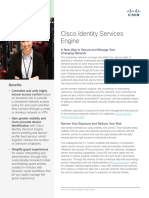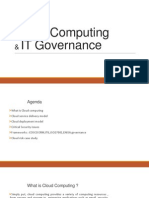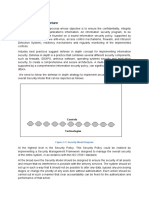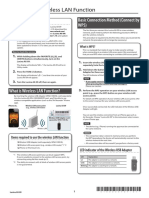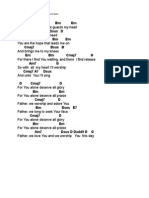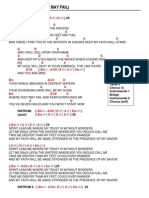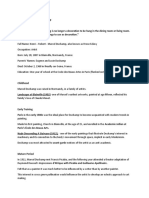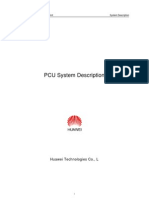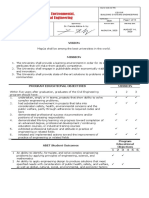Cisco ISE: Technology Partner Ecosystem: At-A-Glance
Cisco ISE: Technology Partner Ecosystem: At-A-Glance
Uploaded by
Franz Mejorada CcieCopyright:
Available Formats
Cisco ISE: Technology Partner Ecosystem: At-A-Glance
Cisco ISE: Technology Partner Ecosystem: At-A-Glance
Uploaded by
Franz Mejorada CcieOriginal Title
Copyright
Available Formats
Share this document
Did you find this document useful?
Is this content inappropriate?
Copyright:
Available Formats
Cisco ISE: Technology Partner Ecosystem: At-A-Glance
Cisco ISE: Technology Partner Ecosystem: At-A-Glance
Uploaded by
Franz Mejorada CcieCopyright:
Available Formats
At-A-Glance
Cisco ISE: Technology Partner Ecosystem
Overview
Increased complexity in network environments has driven the need for a consistent approach to integrating user identity and device information across a variety of IT operations and network platforms. With the advent of mobility, bring your own device (BYOD) policies, software as a service (SaaS), virtualization, and complex cyber threats, it has become necessary to integrate identity and device information into many aspects of network policy and operations to ensure effective network control and oversight. This integration ranges from endpoint management to security analysis. Integrating technology partner platforms with Cisco Identity Services Engine (ISE) enables IT organizations to apply consistent methods to make their platforms identity-, device-, and policy-aware. ISE provides accurate, real-time identity, device, posture, and network access policy context across many ecosystem partner platforms, enabling them to address more use cases and undertake their functions more effectively. Integration with ISE also allows partner platforms to use the Cisco network infrastructure to execute network actions on users and devices, such as quarantine and blocking access. These identity- and device-aware visibility and network response capabilities increase efficiency of operations and help expedite network event resolution. ISE Ecosystem partner integration is accomplished by ISE sharing its user, device, and policy context with the partner; by the partner sharing its context with ISE for use in network access policy; or both. ISE network response capabilities may be extended to the partner platform for executing network actions (Figure 1).
Figure 1. ISE Ecosystem Integration Points
Ecosystem Partner Context ISE
ISE Context Ecosystem Partner
Extend the reach of partner platforms into network access Integrate with centralized policy
ISE
Make partner platforms more e ective with identity and policy enablement
Highlights and Components
The Cisco ISE Ecosystem is composed of Cisco ISE with an Advanced Feature License and a platform from one of our integration partners, including the following ecosystem solutions: Mobile device management (MDM): Integration between Cisco ISE and MDM partner platforms enables posture compliance assessment and network access control of mobile endpoints attempting to access the network. The solution performs ongoing posture checks to ensure compliance and that the correct network access level is maintained. Security event and information management and threat defense (SIEM/TD): Integration with Cisco ISE enables SIEM/TD partner platforms to supplement their networkwide security event visibility with information about user identity, network authorization levels, endpoint device identification, and security posture. This provides a composite, single pane of glass view of a security event from the SIEM/TD partner console. Partners are also able to take remediation actions via ISE; the solution provides complete visibility, contextual assessment, and remediation capabilities from the partner platform.
Make events actionable Decrease time to response
Common Use Cases
Decrease time to event classification Utilize ISE user, device type, access level, and posture information to answer common questions needed to expedite the classification of and response to a network event. Analyze mobile- and device-aware systems Utilize ISE device-type information to create analytics and policies specific to mobile devices. This helps enable a systemwide view of the mobility environment. Differentiate privileges of users and groups Utilize ISE user information to enable oversight for specific users or groups, such as populations with access to highly sensitive data or less trusted populations (guests, for example).
2013 Cisco and/or its affiliates. All rights reserved. Cisco and the Cisco logo are trademarks or registered trademarks of Cisco and/or its affiliates in the U.S. and other countries. To view a list of Cisco trademarks, go to this URL: www.cisco.com/go/trademarks. Third-party trademarks mentioned are the property of their respective owners. The use of the word partner does not imply a partnership relationship between Cisco and any other company. (1110R)
At-A-Glance
Identify devices with security posture failures Utilize ISE endpoint posture information to identify and differentiate endpoints that have a noncompliant posture status. These devices typically represent a higher security risk on the network. Utilize ISE as a unified network access policy point Ease operations with a central policy point instead of numerous individual policy silos across the IT infrastructure. ISE ecosystem partner platforms can provide context to ISE, which can then be applied across the many attributes ISE uses to formulate network access policy.
Benefits
Increased effectiveness of existing operations and security platforms through identity and device awareness Extend the reach of existing operations and security platforms into network access policy by integrating with ISE network policies Decreased time to identify, assess, and respond to network events IT platforms aligned to a consistent source of user, device, policy visibility, and network control
For More Information
Refer to the individual ISE Ecosystem At-a-Glance documents for detailed information regarding each Cisco ISE Ecosystem partner. Detailed information regarding specific partners is available on the Cisco Developer Network Marketplace at http://marketplace.cisco.com/catalog.
2013 Cisco and/or its affiliates. All rights reserved. Cisco and the Cisco logo are trademarks or registered trademarks of Cisco and/or its affiliates in the U.S. and other countries. To view a list of Cisco trademarks, go to this URL: www.cisco.com/go/trademarks. Third-party trademarks mentioned are the property of their respective owners. The use of the word partner does not imply a partnership relationship between Cisco and any other company. (1110R) C45-728402-00 06/13
You might also like
- Refund-Fee Waiver Release TemplateDocument1 pageRefund-Fee Waiver Release TemplateFranz Mejorada Ccie67% (3)
- LPG Spill Prevention and Response ManualDocument2 pagesLPG Spill Prevention and Response ManualGodfrey Jr Jr.100% (1)
- At A Glance c45-728401 PDFDocument2 pagesAt A Glance c45-728401 PDFVarun KaushalNo ratings yet
- Cisco IseDocument3 pagesCisco IseVivek R KoushikNo ratings yet
- Cisco Identity Services Engine (ISE) : Policy AdministrationDocument3 pagesCisco Identity Services Engine (ISE) : Policy Administrationabdel_lakNo ratings yet
- Cisco Identity Services Engine (ISE) : Policy AdministrationDocument3 pagesCisco Identity Services Engine (ISE) : Policy AdministrationJorge Ticona BurgaNo ratings yet
- Cisco Identity Services Engine: BenefitsDocument2 pagesCisco Identity Services Engine: BenefitsMichael O'ConnellNo ratings yet
- Cisco ISE - MDM Partner Integration: Use CasesDocument2 pagesCisco ISE - MDM Partner Integration: Use CasesVarun KaushalNo ratings yet
- Cisco Identity Services Engine: Product OverviewDocument6 pagesCisco Identity Services Engine: Product OverviewMinh HoàngNo ratings yet
- The Cisco BYOD Smart Solution: Rising User and Device DemandsDocument4 pagesThe Cisco BYOD Smart Solution: Rising User and Device Demands1234056780No ratings yet
- Cisco Identity Services Engine: How To BuyDocument8 pagesCisco Identity Services Engine: How To BuyUmAiR ANo ratings yet
- RSa BasicDocument17 pagesRSa BasicGirikikkeriNo ratings yet
- Ise13 RN PDFDocument64 pagesIse13 RN PDFRayan YounesNo ratings yet
- Data Sheet c78-656174Document5 pagesData Sheet c78-656174RealssunNo ratings yet
- Cisco IronPort Web Data Security and Data Loss Prevention OverviewDocument3 pagesCisco IronPort Web Data Security and Data Loss Prevention OverviewShaili SinghalNo ratings yet
- 700-150 Introduction to Cisco SalesDocument9 pages700-150 Introduction to Cisco SalesSebastian van BelzenNo ratings yet
- Cisco Identity Services Engine 1333230959Document5 pagesCisco Identity Services Engine 1333230959Vanessa Arias IzaNo ratings yet
- BYOD WhitepaperDocument2 pagesBYOD WhitepaperSatyapriya PanigrahiNo ratings yet
- 15367098-IsE Ordering GuideDocument7 pages15367098-IsE Ordering GuideBillel ToumiNo ratings yet
- Cisco ISEDocument2 pagesCisco ISEMichaelNo ratings yet
- Cisco FlexpodDocument124 pagesCisco Flexpodcalad03No ratings yet
- Cisco ISE OverviewDocument2 pagesCisco ISE OverviewRaghad JamilNo ratings yet
- Cisco ISE Interview Questions and Answers - NetworkingDocument35 pagesCisco ISE Interview Questions and Answers - NetworkingNagendra ChaudharyNo ratings yet
- Cisco Trustsec Services: Protect Network Access and AssetsDocument2 pagesCisco Trustsec Services: Protect Network Access and AssetsPromise KumaloNo ratings yet
- Data - Sheet - Cisco Identity Services Engine (ISE) PDFDocument6 pagesData - Sheet - Cisco Identity Services Engine (ISE) PDFSenmarche AnnonceNo ratings yet
- Chirag DobariyaDocument7 pagesChirag Dobariyapritesh hansaNo ratings yet
- Cisco Identity Services Engine ExpressDocument3 pagesCisco Identity Services Engine ExpressMinh HoàngNo ratings yet
- Windows Security Threat Protection Security Policy SettingsDocument600 pagesWindows Security Threat Protection Security Policy Settingsfbifido1No ratings yet
- IoT Reference ArchitectureDocument3 pagesIoT Reference ArchitectureYoganathan BNo ratings yet
- CISSP RevisionDocument35 pagesCISSP RevisioneuphremagossoukpeNo ratings yet
- How-To 64 MDM AirWatchDocument19 pagesHow-To 64 MDM AirWatchMichael O'ConnellNo ratings yet
- Cloud Computing - Introduction & GovernanceDocument31 pagesCloud Computing - Introduction & GovernanceprakashprabumNo ratings yet
- Securing The NetworkWADocument9 pagesSecuring The NetworkWAwasirifieNo ratings yet
- Secure Configuration ManagementPolicy Template For CIS Control 4Document19 pagesSecure Configuration ManagementPolicy Template For CIS Control 4Ivan NinanNo ratings yet
- Security ArchitectureDocument9 pagesSecurity ArchitectureVenkatesh PrasadNo ratings yet
- AppGate SDP-Reference Architectures 072020Document21 pagesAppGate SDP-Reference Architectures 072020SivakumarNo ratings yet
- It Asset Management How To Manage Your Information Technology Equipment 4 6Document3 pagesIt Asset Management How To Manage Your Information Technology Equipment 4 6vanxim xoadumNo ratings yet
- Research Paper On Embedded System SecurityDocument4 pagesResearch Paper On Embedded System Securityefhwx1vt100% (1)
- Security Architecture Best Practice by Bob Panic WhitepaperDocument22 pagesSecurity Architecture Best Practice by Bob Panic Whitepaperapi-111740184No ratings yet
- PDF Dnac SdaDocument443 pagesPDF Dnac SdaPiyumal RajapaksheNo ratings yet
- SaaS ISMS Implementation NotesDocument70 pagesSaaS ISMS Implementation NotesCheharaPustak0% (1)
- For Midterm POINTERSDocument16 pagesFor Midterm POINTERSkhen kevin modesioNo ratings yet
- Gartner SIEMDocument2 pagesGartner SIEMcryptraryNo ratings yet
- 64515be8dcef055c21dde634 Illumio FAQDocument7 pages64515be8dcef055c21dde634 Illumio FAQferranti.mNo ratings yet
- Fortinet Piranha BattlecardDocument12 pagesFortinet Piranha BattlecardHugo Cesar Flores OrtizNo ratings yet
- Network Defense: Layered Defense or Defense-In-DepthDocument16 pagesNetwork Defense: Layered Defense or Defense-In-DepthKaram AlMashhadiNo ratings yet
- Unit V - Security in The CloudDocument10 pagesUnit V - Security in The CloudsundarNo ratings yet
- Dns Secure Email Nist sp1800 6aDocument5 pagesDns Secure Email Nist sp1800 6aBlack manNo ratings yet
- SC 100t00a Enu Powerpoint 02Document74 pagesSC 100t00a Enu Powerpoint 02Roshan YalburgiNo ratings yet
- SOC Interview Questions and Answers 1716919142Document26 pagesSOC Interview Questions and Answers 1716919142Raghavendar Reddy BobbalaNo ratings yet
- Cloud Security - A Primer by Yogesh Gupta, CISSP® CCSK CCSP - The Cloud, Services, Standards - PeerlystDocument8 pagesCloud Security - A Primer by Yogesh Gupta, CISSP® CCSK CCSP - The Cloud, Services, Standards - PeerlystrossloveladyNo ratings yet
- ISO27k Toolkit Overview Andh Contents 5v2Document8 pagesISO27k Toolkit Overview Andh Contents 5v2Ghulam HussainNo ratings yet
- 1583082352381Document11 pages1583082352381shanmugam thevapriyanNo ratings yet
- NextGen NAC GuideDocument14 pagesNextGen NAC GuideLalu VijayanNo ratings yet
- Amendment 6 Thunderdome RFI - Revised - 6.10.2021Document6 pagesAmendment 6 Thunderdome RFI - Revised - 6.10.2021kevinzhangNo ratings yet
- Cisco Chapter's 5,6,7,8Document25 pagesCisco Chapter's 5,6,7,8Break FastNo ratings yet
- Essential SASE Must-HavesDocument2 pagesEssential SASE Must-Havestola02000No ratings yet
- Arcsight CiscoDocument23 pagesArcsight CiscoKrishna KumarNo ratings yet
- SC 100t00a Enu Powerpoint 01Document60 pagesSC 100t00a Enu Powerpoint 01Roshan YalburgiNo ratings yet
- Securing Manufacturing Computing and Controller Assets: Rockwell Automation and Cisco Four Key InitiativesDocument10 pagesSecuring Manufacturing Computing and Controller Assets: Rockwell Automation and Cisco Four Key InitiativesNilesh ChavanNo ratings yet
- Task 4 (2000 Words)Document10 pagesTask 4 (2000 Words)Nadia RiazNo ratings yet
- Security Operations Center - Analyst Guide: SIEM Technology, Use Cases and PracticesFrom EverandSecurity Operations Center - Analyst Guide: SIEM Technology, Use Cases and PracticesRating: 4 out of 5 stars4/5 (1)
- CCIE Documentation CDDocument3 pagesCCIE Documentation CDFranz Mejorada CcieNo ratings yet
- Actualtest CCIE RS v5Document160 pagesActualtest CCIE RS v5Franz Mejorada CcieNo ratings yet
- Ipv4 Addressing Chart: Starting Network 190.190.8.0 /20Document2 pagesIpv4 Addressing Chart: Starting Network 190.190.8.0 /20Franz Mejorada CcieNo ratings yet
- Happy Day (Jesus Culture) (G)Document2 pagesHappy Day (Jesus Culture) (G)Franz Mejorada CcieNo ratings yet
- HCNA ReviewerDocument69 pagesHCNA ReviewerFranz Mejorada Ccie100% (5)
- Multicast CCIEDocument12 pagesMulticast CCIEFranz Mejorada CcieNo ratings yet
- AX-09 L Wireless E01 WDocument4 pagesAX-09 L Wireless E01 WFranz Mejorada CcieNo ratings yet
- CCIE Study ApproachDocument1 pageCCIE Study ApproachFranz Mejorada Ccie50% (2)
- You AloneDocument1 pageYou AloneFranz Mejorada CcieNo ratings yet
- Oceans (Where Feet May Fail) : (Hillsong United - Zion)Document1 pageOceans (Where Feet May Fail) : (Hillsong United - Zion)Franz Mejorada CcieNo ratings yet
- Sing Sing SingDocument4 pagesSing Sing SingFranz Mejorada CcieNo ratings yet
- Do It Again: Words and Music by Jonathan HuntDocument2 pagesDo It Again: Words and Music by Jonathan HuntFranz Mejorada CcieNo ratings yet
- TBSMini6 - E - B - TBS Mini ManualDocument11 pagesTBSMini6 - E - B - TBS Mini ManualAnkh TharaNo ratings yet
- Biography of Marcel DuchampDocument2 pagesBiography of Marcel DuchampVargas John LloydNo ratings yet
- 1920 PostMock02 Paper02Document15 pages1920 PostMock02 Paper02Samuel WongNo ratings yet
- PCU V300R005 System DescriptionDocument36 pagesPCU V300R005 System DescriptionbaratepaNo ratings yet
- 2023-24 M. Scheme 1 PreboardDocument7 pages2023-24 M. Scheme 1 Preboardepic1941tNo ratings yet
- Co Unitwise Questions NewDocument13 pagesCo Unitwise Questions NewSai VenkateshNo ratings yet
- Company ProfileDocument7 pagesCompany ProfileAdarsha ANo ratings yet
- Machine LerningDocument15 pagesMachine LerningFadly SaputraNo ratings yet
- PanizDocument6 pagesPanizgeorgiana georgiNo ratings yet
- Final MPH - Course Handbook 2022-24Document85 pagesFinal MPH - Course Handbook 2022-24Manish GoswamiNo ratings yet
- Triangle of VelocityDocument4 pagesTriangle of VelocitykeerthanaNo ratings yet
- PNST Form PDFDocument1 pagePNST Form PDFega anjaniNo ratings yet
- Lutron Malv Specs MAW 600H WHDocument10 pagesLutron Malv Specs MAW 600H WHPeruskia PapNo ratings yet
- Ice Cream Emulsifiers and Stabilisers - by PalsgaardDocument8 pagesIce Cream Emulsifiers and Stabilisers - by Palsgaardcampeon00magnatesNo ratings yet
- Slides BacktestingDocument61 pagesSlides BacktestingAdityo SanjayaNo ratings yet
- Cardiovascular SystemDocument39 pagesCardiovascular SystemdumbledoreaaaaNo ratings yet
- LRN Level B1 January 2019 Exam Paper PDFDocument14 pagesLRN Level B1 January 2019 Exam Paper PDFMaria JoviNo ratings yet
- CE151P-2 Course SyllabusDocument15 pagesCE151P-2 Course SyllabusMela TumanganNo ratings yet
- Tutorial 1/mat 455: Geometric Series or A P-Series - Determine Whether It Is ADocument10 pagesTutorial 1/mat 455: Geometric Series or A P-Series - Determine Whether It Is Asimon georgeNo ratings yet
- 1.1 ASME B31.3, Acceptance Criteria 1.2: Acceptance Criteria For Weld Defects As Per Different CodeDocument2 pages1.1 ASME B31.3, Acceptance Criteria 1.2: Acceptance Criteria For Weld Defects As Per Different CodeSTEPHEN RAJANNo ratings yet
- Seamus Heaney - Seeing Things (1991, FSG) - Libgen - LiDocument123 pagesSeamus Heaney - Seeing Things (1991, FSG) - Libgen - Limel woodsNo ratings yet
- OREAS 992 CertificateDocument5 pagesOREAS 992 CertificateVivianne PerezNo ratings yet
- Siop Lesson Final Draft and ReflectionDocument5 pagesSiop Lesson Final Draft and Reflectionapi-346232774No ratings yet
- Durability, Behavior, and Tolerability of 5 HialuronidaseDocument9 pagesDurability, Behavior, and Tolerability of 5 HialuronidaseMonica Alejandra Aguirre RiveraNo ratings yet
- Ipc B46LPDocument2 pagesIpc B46LPsurf666No ratings yet
- Monnier 4P Overview FNLDocument4 pagesMonnier 4P Overview FNLLuqman BhanuNo ratings yet
- GHITS Portal User Guide v1.7Document79 pagesGHITS Portal User Guide v1.7Avi KapoorNo ratings yet
- Steel Design Fourth Edition William T Segui Solution Manual PDFDocument3 pagesSteel Design Fourth Edition William T Segui Solution Manual PDFGerardo Medrano0% (1)
- Population DynamicsDocument5 pagesPopulation DynamicsUmair100% (1)






